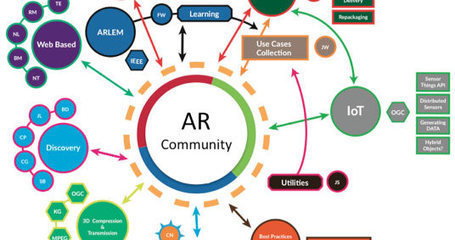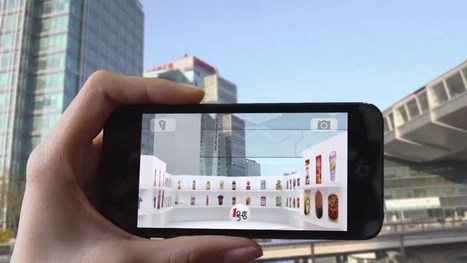Enterprise Augmented Reality engineers and content managers who published experiences created with Metaio’s software tools have or will soon encounter a situation they didn’t anticipate: the publishing and delivery environments are unsupported and not evolving to take advantage of the latest enabling technologies.
Get Started for FREE
Sign up with Facebook Sign up with X
I don't have a Facebook or a X account


 Your new post is loading... Your new post is loading...
 Your new post is loading... Your new post is loading...
Over the past few years, augmented reality has become really popular for its practical use in different industries. Now, along with this technology, wearable technology is also making its presence felt. The value of these devices will grow even more in the coming years and AR will play a significant role in it. Here are five trends related to augmented reality which have been predicted by the Co-Founder and CEO of augmentedreality.org , Ori Inbar. The company is a non-profit one and is dedicated to progress AR.
Mirko Compagno's insight:
Five AR Trends for 2014
1. AR is now a Valuable Solution
2. Extensive use of AR in Wearable devices
3. 3D View of the World
4. AR Moves to Enterprise
5. Emergence of a New Interface
|
A new iPad app from online artwork marketplace Pixels.com allows consumers to visualize artwork on their walls before purchasing. Push notifications keep consumers up to date with favorite artists. When Sean Broihier, the founder and CEO of online artwork marketplace Pixels.com thought about launching an app, he didn’t want to just recreate the content on the marketplace’s web site. After all, Broihier—who does all the programming for the company’s web sites and apps—had just launched a responsive design web site a year ago.
Mirko Compagno's insight:
That web site allows consumers to browse and shop the pieces from artists and photographers in Pixels.com’s catalog. But an app should offer something more, Broihier says. It’s a big leap to expect that a consumer will go out and find a brand’s app, download that app and then shop in the exact same way she can on a web site. “You really have to offer consumers something that’s truly unique in the app,” he says.
And what’s the unique thing in Pixels.com’s app? It’s an augmented reality component called “View On Your Wall” that leverages the iPad’s camera to allow consumers to visualize a specific piece of artwork on their wall before purchasing.
A consumer prints a target and attaches that to her wall where she wants to visualize the artwork. Using the iPad app, she holds the iPad facing the wall, selects a piece of artwork, and the artwork will appear on the wall within the iPad’s screen. If she tilts the iPad, the artwork visualization will tilt with her.
She can try out different sizes, framing options and a variety of art. Once the artwork looks exactly the way she wants it, she presses the Buy button, which locks in the changes and selections she made while visualizing the art on her wall.
The app also includes a social media component that allows consumers to follow their favorite artists, photographers, artwork and photographs and share them with their friends—all within the app. If consumers sign up for push notifications—alerts that pop up regardless of whether an app is open or closed or whether a smartphone or tablet is on or sleeping—they receive a notification when a favorite artist or photographer uploads new work.
Artists and photographers upload artwork to Pixels.com and decide what prices they want to charge for specific sizes. For example, if a photographer uploads an image of a skyline and sets the price for an 8x10 at $10, Pixels.com will give the photographer $10 for each 8x10 sold. Pixels.com marks up the price to the consumer. The cost of frames and matting is added on as well. For example, if an artist wants to receive $500 for an 8x10 artwork, and a customer adds matting that costs $20, Pixels.com might sell the artwork to the consumer for $600.
Graphic wall design e-retailer Fathead debuted a similar mobile app last year. Dubbed Big Shot, the iPhone and Android app was built with Detroit Labs, a sister firm under an umbrella company owned by Quicken Loans creator Dan Gilbert.
A consumer prints off a target and tapes it to her wall in her home, then opens the app, selects the Fathead graphic she wants to see on her wall, then snaps a picture of the target from eight to 10 feet away.
The target is needed so the app can properly scale the large graphic to the wall. She then has a picture of the graphic in her home that she can share with friends and family via Facebook. Pixels.com has gone many steps further, enabling consumers to add frames and other customizations and then lock in a selection and make a purchase in the app. |











Are you among this group? If so, you are not the only one to find yourself in this uncomfortable situation.
If there was a mandate to continue providing the value of their AR experiences to end users, customers of other AR software providers who are no longer supporting or advancing their platforms with the latest technology innovations hit the same roadblock.
Prior to agreement on standards, they could not “port” their experiences to another AR platform. Evaluating and choosing another proprietary AR technology platform, and then investing in re-authoring, testing and re-deploying AR experiences based on their original designs, was the only way forward.
Unfortunately, some of those reading this blog are in this awkward position today.
Successfully addressing the root causes of low AR experience “portability” and the inherent lack of integration or interoperability between AR authoring and publishing systems is an important, highly collaborative process. Different parts of the AR ecosystem must agree that there are issues, firstly, and then on principles for collaboration. Then, based on shared conceptual frameworks, they must work together towards implementing those principles in their workflows and solutions.
Supporting that collaborative process is the reason I’ve been leading the grassroots community for open and interoperable Augmented Reality content and experiences since 2009.
Is There Really a Problem?
Interoperable Augmented Reality is not a high priority for most people. Only about a hundred people are consistently investing their time in advancing the principles of open and interoperable Augmented Reality. We know one another on a first name basis; many of us compare notes in person a few times per year. Another few hundred people know of such activities but don’t directly invest in meaningful ways.
For most companies, the investment in AR has not been great. A few tens of thousands of dollars to rebuild and deploy a half dozen carefully handcrafted AR experiences is minor by comparison to investments in other enterprise technologies.
“There’s still too much innovation to begin working on standards,” is another commonly heard refrain. Clearly they haven’t been reading the posts or listening to the presentations made by AREA member IEEE Standards Association, or leaders of other standards development groups. When designed collaboratively and to address interoperability in strategic places, there are many examples of standards doing the reverse.
There are other reasons for many to turn a blind eye to the problems. They are valid for different people to different levels.
This is a Serious Problem
In my opinion, ignoring the lack of open and interoperable Augmented Reality solutions and services is doing everyone a disservice.
The fact that only a relatively low amount of money has been invested to date is a poor justification for investing yet more time and money into building experiences with another proprietary platform, only to have the same scenario in a matter of months or years.
In fact, innovation in Augmented Reality is not what it should be today because many of the best AR developers are building a better mouse trap: smart engineers are working to solve problems that have, for the most part been solved by others, in a different way. Whether it’s for reasons of avoiding encroachment on a third party’s patents or something else, this investment of effort is in highly integrated proprietary silos and at the expense of solving other problems that remain unaddressed.
There are three more serious problems with having only proprietary technology silos and very low use of widely agreed standards for Augmented Reality experiences. The first of these is that enterprises with assets that could be leveraged for AR experiences are unable to integrate production of AR experiences into their corporate workflows. T
his lack of integration between AR as a method of information delivery and other information delivery systems (e.g., web pages and mobile services without AR support) means we can’t seriously stand before a CIO and recommend they support the development of AR content. What we are recommending requires setting up another entirely separate and different content management system.
In the same vein, the second reason that enterprise CIOs and CFOs are justifiably reluctant to deepen their investment in AR projects is that they cannot deploy modular architectures in which multiple vendors can propose different components. In today’s landscape of offerings, it’s all or nothing. The customer can buy into provider A’s system or that offered by provider B. If provider C comes along with a better option, too bad.
The third reason the lack of standards is a serious problem worthy of your support is closely related to the other two. Deep collaboration between AR-enabling technology vendors (providers of technologies) and service providers is currently very difficult.
They are not working to improve customer outcomes: they are working much more on competing with one another for attention and for the small investments that might be made.
Three serious enterprise AR obstacles that agreements about open and interoperable AR could reduce:
1) Low or lack of content or experience portability between proprietary technology silos;
2) Strong customer aversion to risks due to vendor lock-in;
3) Low cooperation between competitors or ecosystem members to partner for best customer outcomes.
This situation with lack of interoperability and fear of vendor lock-in would be addressed if the vendors took a more serious look at possible open interfaces and standards within a larger framework. Conversely, vendors might study new approaches and establish some level of interoperability if they believed that customers would respond by increasing their budgets for Augmented Reality.
This is all very serious.
Another recent development is not helping: it’s clear that some internet and IT giants are paying a lot of attention to AR. The lack of visibility into what highly competitive and successful companies like Microsoft, Google, Apple and PTC will do about AR interoperability and integration has cast a very cold spell over enterprise AR adoption.
Their lack of support for standards and their unwillingness (to date) to shed light in a public way on how they will cooperate or how their proposed (future) systems will interoperate is causing so much uncertainty. No CIO or CFO should seriously invest in enterprise Augmented Reality until these companies’ plans with respect to integration and interoperability are clearer.
Progress is Being Made
We should be open to the possibility that 2016 will be different.
Thanks to the dedication of members of the grassroots community, the situation is not as bleak as it could be.
A few weeks ago a few dozen members met in Seoul, Korea, to compare notes on progress. SK Telecom, a strong supporter of open and interoperable Augmented Reality, hosted two days of sessions. We heard status updates from four standards organizations that have highly relevant activities ongoing (Khronos Group, Open Geospatial Consortium, IEEE and ISO/IEC). We also received reports from AR developers who are working to advance their solutions to support standards.
The fact that the ISO/IEC JTC1 Joint Adhoc Group for Mixed and Augmented Reality Reference Model is nearing completion of its work is a major development about which I presented in Seoul.
In the spirit of full disclosure: the community of people in support of open and interoperable AR was the environment in which this work began, and I have been a member of that ad hoc group since its formation. If you would like to obtain a draft of the Mixed and Augmented Reality Reference Model, please send me an email request.
We are also seeing increased interest from industry-centric groups. There is a German government supported project that may propose standards for use in automotive industry AR. The results of an EU-funded project for AR models in manufacturing became the basis for the establishment of the IEEE P1589 AR Learning Experience Model working group (which I co-chair).
In a recent meeting of oil and gas industry technologists, formation of a new group to work on requirements for hands-free display hardware was proposed.
These are all encouraging signs that some are thinking about open and interoperable Augmented Reality. If you want to monitor the activities of the grassroots community focusing on this topic, and to receive announcements of upcoming meetings, visit this page and register yourself for one or more of the mailing lists.
Have you seen other signs that there is increasing awareness of the problems? Do you know about any new standards that should be monitored by and presented during a future meeting of the grassroots community?